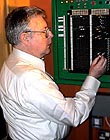|
|
This topic comprises 3 pages: 1 2 3
|
|
Author
|
Topic: Making Cue Marks
|
|
|
Leo Enticknap
Film God

Posts: 7474
From: Loma Linda, CA
Registered: Jul 2000
|
 posted 01-13-2005 11:39 AM
posted 01-13-2005 11:39 AM





You really need a purpose-designed cue mark scriber such as an Acmade or a Clint Phare.
If, for whatever reason you can't get your hands on one of those, I can think of two possible solutions.
- Method 1: stick one layer of splicing tape across the base side of the film where the motor and over cues would normally be. Instead of watching for the mark, listen for the 'click' as the tape goes through the gate, as your cue. When rewinding each reel for the last time, peel the tape off. This would be my first choice, but if your booth is very noisy and depending on what projectors you have, you might not be able to hear the clicks very easily. And if your print is totally shagged and has lots of joins in it anyway, you might get confused as to which click is the one to act on. If in doubt, experiment with a loop of scrap film before trying it with an audience.
- Method 2: very lightly make diagonal slashes on the base side of four consecutive frames, where the cues would normally be, using a white Chinagraph pencil. Unless the image is very dark you'll see these as easily as lab cues. This is not ideal, because the audience will see them too - they'll be more noticeable than proper cues. But if there's no other option, it should get you out of trouble. When rewinding each reel for the last time, rub them off gently using a lint-free cloth. They should come off without leaving any trace that they were there.
| IP: Logged
|
|
Stephen Furley
Film God

Posts: 3059
From: Coulsdon, Croydon, England
Registered: May 2002
|
 posted 01-13-2005 12:22 PM
posted 01-13-2005 12:22 PM




What I sometimes do is to make dots with a spirit based 'permanent' pen on the base side of the film. If I'm going to run the print several times then I sometimes cover them with tape to prevent them rubbing off. After the last show they can be removed with a drop of alcohol on a cloth.
Is this a normal release print, or an 'archive' one? If the latter you should avoid doing anything irreversible to it without the permission of the owner.
If the corner of the frame is dark, then any form of ink or pencil cues may be difficult to see. In this case you have three options:
Leo's method one.
Put ink or pencil cues elsewhere on the frame.
Scribe cues.
The first is the best option if you can do it.
The second avoids permanently marking the print, but you have to be careful to remember, and to make sure that anyone else running the print knows, that the cues are in a non-standard place, e.g. in the bottom right, or top left corner.
If you have to scribe cues then you should use a proper marker; roughly hand scribed ones, which vary in size, shape and position from frame to frame, look terrible.
If you get a print which has cues, but they're in the wrong place, either because somebody has done it wrong, or because frames have been lost at the end of the reel, if you possibly can, avoid making new cues in the correct place; use the existing ones, and adjust your starting frame, and changeover timing, to compensate.
Write down details of the cues on the film sheet, as a reminder to yourself, and make sure any other projectionist reads them. e.g.
Motor cue: scribed circles, 5 frames late
Changeover cue: black printed dots, 2 frames early.
If you find that somebody has made multiple sets of oversized, hand scribed cues all over the print, say something very unpleasant about them!
| IP: Logged
|
|
|
|
|
|
William Hooper
Phenomenal Film Handler
Posts: 1879
From: Mobile, AL USA
Registered: Jun 99
|
 posted 01-14-2005 01:24 AM
posted 01-14-2005 01:24 AM





Making those click strips with a bit of masking tape attached & perforated on the sprocket edge is an old, old method, & has been used for daily runs in changeover houses. They'll make enough noise to be heard. As Brad says, if the projector is hard on film, they'll degrade, but if you're running garden-variety Simplexes or Century's, they should hold up fine. Just before running them would be a good excuse to check the gate band tension with the regularly-done cleaning of the bands, runners, rollers, sprockets, sound drum, etc. in the film path.
Edit:
I just discovered there is no manual for the Clint Phare marker in the manuals section, & am emailing a scan of the original origami-folded instructions immediately to Brad. Do they expect people to just look at this complicated device & guess how it works?
[ 01-14-2005, 02:36 AM: Message edited by: William Hooper ]
| IP: Logged
|
|
|
|
|
|
|
|
|
|
|
|
|
|
|
|
|
|
|
|
|
|
All times are Central (GMT -6:00)
|
This topic comprises 3 pages: 1 2 3
|
Powered by Infopop Corporation
UBB.classicTM
6.3.1.2
The Film-Tech Forums are designed for various members related to the cinema industry to express their opinions, viewpoints and testimonials on various products, services and events based upon speculation, personal knowledge and factual information through use, therefore all views represented here allow no liability upon the publishers of this web site and the owners of said views assume no liability for any ill will resulting from these postings. The posts made here are for educational as well as entertainment purposes and as such anyone viewing this portion of the website must accept these views as statements of the author of that opinion
and agrees to release the authors from any and all liability.
|

 Home
Home
 Products
Products
 Store
Store
 Forum
Forum
 Warehouse
Warehouse
 Contact Us
Contact Us




 Printer-friendly view of this topic
Printer-friendly view of this topic


















